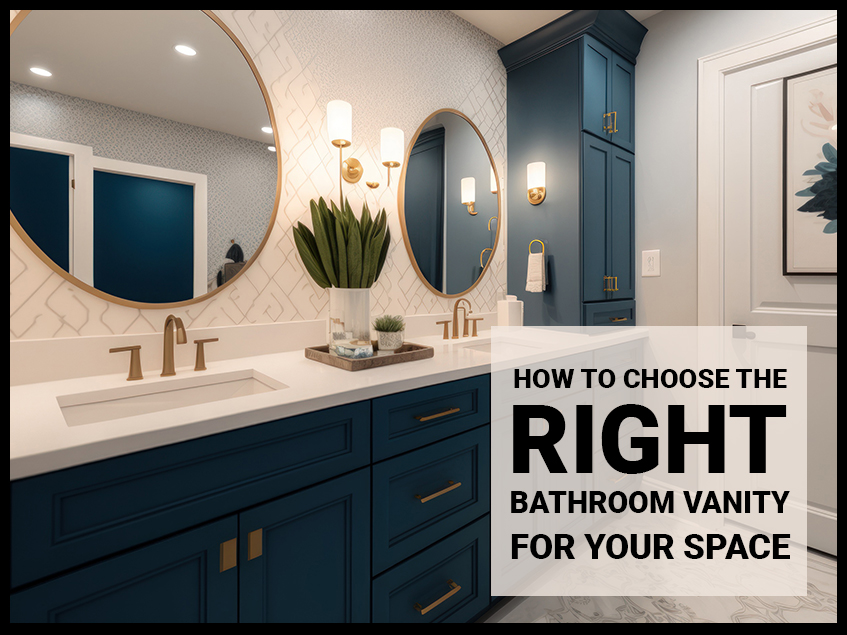How to Choose the Right Bathroom Vanity for Your Space

When it comes to bathroom design, the vanity is more than just a functional fixture—it sets the tone for your entire space. Whether you're doing a full renovation or a simple update, choosing the right bathroom vanity can significantly enhance both the look and functionality of your bathroom.
1. Consider the Size of Your Bathroom
Before selecting a vanity, measure your available space. In compact bathrooms or powder rooms, go for a space-saving single vanity or a wall-mounted design that creates a sense of openness. For larger bathrooms, double vanities or extended countertops offer convenience and extra storage, making them ideal for shared spaces.
2. Understand Your Storage Needs
Evaluate how much storage you need. If your bathroom lacks cabinetry, opt for vanities with built-in drawers, shelves, or organizers. This is especially useful for storing everyday essentials like toiletries, makeup, towels, and cleaning supplies.
3. Choose a Style That Matches Your Space
Bathroom vanities come in various styles—modern, traditional, rustic, farmhouse, and more. Choose one that complements your existing décor. Neutral tones like white, gray, and wood finishes remain timeless, while bold colors like navy and matte black are gaining popularity in 2025 bathroom design trends.
4. Sink and Countertop Options
Vanities often come with integrated sinks or countertops, but you can also opt for a custom look. Choose from undermount, vessel, or integrated sinks depending on your aesthetic and cleaning preference. Durable countertop materials like quartz, marble, and granite are ideal for withstanding daily use.
5. Plumbing Compatibility
Always consider the placement of your plumbing. It’s best to select a vanity that works with your current plumbing layout unless you’re doing a full remodel and moving pipes. This will help you avoid extra installation costs and delays.
6. Think About Functionality
Look for features like soft-close drawers, adjustable shelving, and pre-cut openings for faucets and plumbing. These small details enhance everyday usability and make maintenance easier.
7. Quality & Material
A bathroom is a high-moisture environment, so it's important to choose a vanity made from moisture-resistant and long-lasting materials. Solid wood, plywood, and MDF with proper sealing offer durability and prevent warping or damage over time.
Shop Bathroom Vanities at Fit Cabinetry
At Fit Cabinetry, we offer a range of high-quality, Ready-to-Assemble (RTA) bathroom vanities in various sizes, styles, and finishes. Whether you're updating a guest bath or creating your dream master suite, we make it easy to find the perfect fit for your space—without compromising on quality or design.
Explore our collection at www.fitcabinetry.com
Frequently Asked Questions (FAQs)
Q1. What size vanity do I need for my bathroom?
Measure your bathroom layout and leave at least 18 inches of clearance on each side if possible. Common sizes range from 24” for small spaces to 72” for double vanities.
Q2. What’s the difference between a freestanding and wall-mounted vanity?
Freestanding vanities rest on the floor and offer more storage, while wall-mounted (floating) vanities create a sleek, modern look and make small bathrooms appear larger.
Q3. Can I install a bathroom vanity myself?
If you’re handy and have some plumbing knowledge, DIY installation of an RTA (Ready-to-Assemble) vanity is possible. However, it’s often best to consult a professional for plumbing work.
Q4. What materials are best for bathroom vanities?
Plywood and solid wood are most durable. MDF is budget-friendly but should have a moisture-resistant finish. For countertops, quartz and granite are top choices for durability.
Q5. How do I match the vanity to my existing bathroom style?
Look at your bathroom’s color scheme, hardware, and lighting. Choose a vanity that complements those elements or use it as a statement piece to redefine your space.




